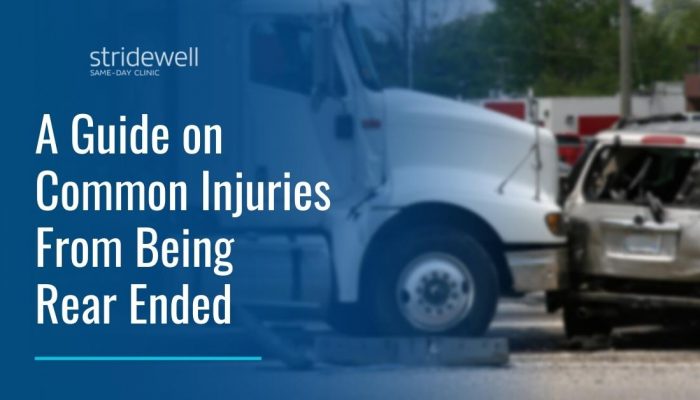Anywhere from minor dents and bruises to a destroyed automobile can result in common car accident injuries and damages from a rear-end collision (when the front of one vehicle collides with the back of another).
Accidents involving the back of a vehicle are very prevalent. Crashing into another car from behind is a “rear-end collision”. It’s common for this to happen if the vehicle behind you follows too closely or drives too fast.
It is common for people to underestimate how severe their injuries are and how much medical attention and treatment they need. Regardless of how insignificant the damage appears to be, you must treat any accident carefully.
Rear-end collisions account for approximately 29% of car accidents resulting in injuries or fatalities each year. Some of the common injuries from being rear-ended will be discussed below.
Common Injuries
When a car is rear-ended, the body is put through stress and movement, leading to injury. It’s not uncommon to experience a sharp jerk after being rear-ended. You could be restrained by your seat belt, whether you have an airbag or not, and end up hitting the steering wheel, dashboard, or the front seat.
It is possible to injure the face, head, and body despite less force applied by a seatbelt or airbag. Additionally, the whipping motion of the head causes soft tissue, nerve, and spinal damage. A specialist must conduct a general evaluation to assess your case properly and recommend a specialized treatment for recovery.
Whiplash
In rear end collisions, whiplash, or neck strain, is a common injury. This injury can cause discomfort in the neck, headaches, and stiffness or paralysis. Severe whiplash may cause pain, weakness, or numbness in the arms and shoulders.
Seat Belt Injuries
There is no denying that seat belts save lives. On the other hand, seat belts have been known to injure people in rear-end car accidents. If your car is rear-ended, your seat belt tightens automatically to prevent you from hitting the steering wheel, dashboard, or windshield. As a result, if you’re thrown forward in a collision, the seat belt may slash your skin. Seat belts most commonly cause chest, neck, and torso injuries.
However, always remember to protect yourself from drunk, aggressive, and inattentive drivers by wearing a seatbelt. Being belted up helps keep you within the vehicle; being ejected from the vehicle is almost always fatal.
Back Injuries
There are numerous ways your spine might be harmed after an accident. A herniation or rupture of the discs between your vertebrae can cause pain and numbness in other parts of your body. Whiplash-like back strains and sprains are also possible, and both can be excruciatingly painful.
Head Injuries
No matter how fast the vehicles are moving, a rear-end collision should always be taken seriously, as this poses a risk for head injuries. An impaled or struck skull can still occur even if airbags deploy correctly. This can lead to a concussion, loss of consciousness, lacerations, swelling, bruises, and other unpleasant side effects like these:
Symptoms of traumatic brain injury may not be immediately apparent, and it may take days or weeks for the full ramifications of the injury to emerge.
Spinal Injuries
Car accidents can cause vertebral discs, the cushions that protect the spine, to slip out of place or herniate. Pain, numbness, and even lower-extremity dysfunction may ensue from a nerve injury. Paralysis can develop from damage to the spinal cord. When this happens, a person may be unable to return to work, or their life may be irreparably altered. It is also feasible to receive therapy and rehabilitation for the rest of one’s life.
Crushed limbs
Crashing into an oncoming vehicle or the back of another vehicle is possible when there is a serious car collision. A spinal injury can render a victim partially or entirely paralyzed in any of these scenarios. Spinal injuries might be irreversible or necessitate months or even years of therapy and recovery.
In severe rear-end collisions, the legs might be crushed or mutilated. In some cases, the patient may choose between saving or amputating the limb in question. Their leg might be missing, and they may have been sent to the hospital.
Amputations and limb crumpling are severe injuries that frequently demand many surgeries and lengthy stays in the hospital.
Always check yourself for injuries
Check your body for injuries even if you don’t feel any signs of pain. Examples include wrist sprains and strains, bulging disks (or herniation), and aggravated pre-existing problems. Rear-end crash injuries can take months to manifest.
If you’re surprised, your adrenaline levels may be sky-high. So, go to the nearest hospital emergency department first. Especially if your automobile has been damaged, notify your insurance company of the crash. As a result, your medical bills and vehicle damage may be covered in full by your insurance.
If you’ve been in a car accident, get immediate medical attention. Many rear-end collision injuries aren’t immediately apparent. Damage to the spinal cord and brain are two examples of long-term consequences. If an injury is detected quickly, it can be treated more rapidly.
Muscle strains are commonly treated with painkillers and physical therapy. Nerve injuries may never completely heal. If you’re hit from behind, you run the risk of suffering long-term pain and disability.
Contact Stridewell to learn more about common injuries from being rear-ended
In the period following an accident, it’s vital to remember that the victim may not feel any pain. Adrenaline rushes from being rear-ended can exacerbate neck and back injuries, in particular. Even if you haven’t felt anything since your vehicle accident, you should still see a doctor as soon as possible because there may still be lasting injuries and problems.
Contact a trusted injury clinic like Stridewell today to learn more about common injuries from being rear-ended.
read article



